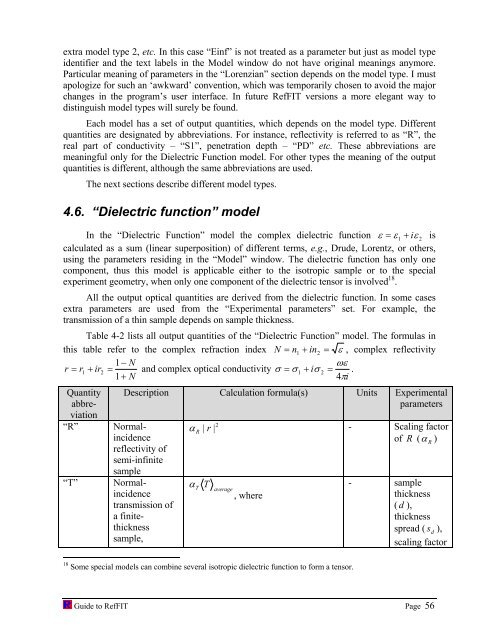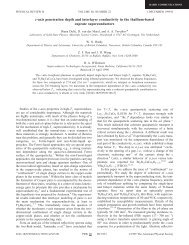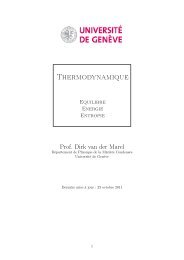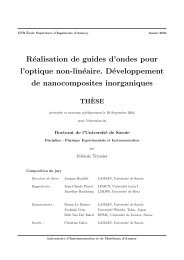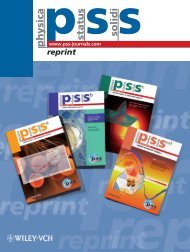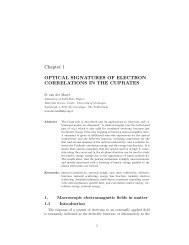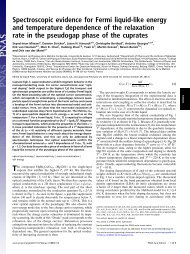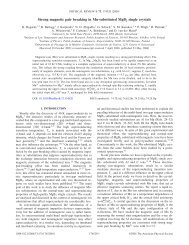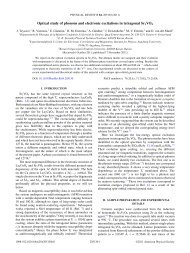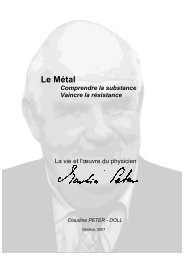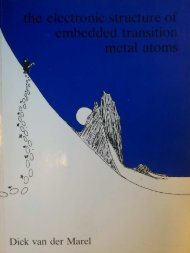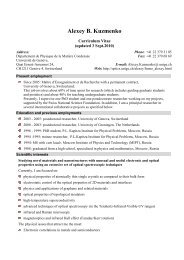software to fit optical spectra - Quantum Materials Group
software to fit optical spectra - Quantum Materials Group
software to fit optical spectra - Quantum Materials Group
You also want an ePaper? Increase the reach of your titles
YUMPU automatically turns print PDFs into web optimized ePapers that Google loves.
extra model type 2, etc. In this case “Einf” is not treated as a parameter but just as model type<br />
identifier and the text labels in the Model window do not have original meanings anymore.<br />
Particular meaning of parameters in the “Lorenzian” section depends on the model type. I must<br />
apologize for such an ‘awkward’ convention, which was temporarily chosen <strong>to</strong> avoid the major<br />
changes in the program’s user interface. In future RefFIT versions a more elegant way <strong>to</strong><br />
distinguish model types will surely be found.<br />
Each model has a set of output quantities, which depends on the model type. Different<br />
quantities are designated by abbreviations. For instance, reflectivity is referred <strong>to</strong> as “R”, the<br />
real part of conductivity – “S1”, penetration depth – “PD” etc. These abbreviations are<br />
meaningful only for the Dielectric Function model. For other types the meaning of the output<br />
quantities is different, although the same abbreviations are used.<br />
The next sections describe different model types.<br />
4.6. “Dielectric function” model<br />
In the “Dielectric Function” model the complex dielectric function ε = ε1<br />
+ iε<br />
2 is<br />
calculated as a sum (linear superposition) of different terms, e.g., Drude, Lorentz, or others,<br />
using the parameters residing in the “Model” window. The dielectric function has only one<br />
component, thus this model is applicable either <strong>to</strong> the isotropic sample or <strong>to</strong> the special<br />
experiment geometry, when only one component of the dielectric tensor is involved 18 .<br />
All the output <strong>optical</strong> quantities are derived from the dielectric function. In some cases<br />
extra parameters are used from the “Experimental parameters” set. For example, the<br />
transmission of a thin sample depends on sample thickness.<br />
Table 4-2 lists all output quantities of the “Dielectric Function” model. The formulas in<br />
this table refer <strong>to</strong> the complex refraction index N = n1<br />
+ in2<br />
= ε , complex reflectivity<br />
1−<br />
N<br />
ωε<br />
r = r1<br />
+ ir2<br />
= and complex <strong>optical</strong> conductivity σ = σ 1 + iσ<br />
2 = .<br />
1+<br />
N<br />
4πi<br />
Quantity<br />
abbre-<br />
viation<br />
“R” Normalincidence<br />
reflectivity of<br />
semi-infinite<br />
Description Calculation formula(s) Units Experimental<br />
parameters<br />
sample<br />
“T” Normalincidence<br />
transmission of<br />
a finitethickness<br />
sample,<br />
2<br />
α R | r |<br />
- Scaling fac<strong>to</strong>r<br />
T T α<br />
average<br />
, where<br />
18 Some special models can combine several isotropic dielectric function <strong>to</strong> form a tensor.<br />
of R ( α R )<br />
- sample<br />
thickness<br />
( d ),<br />
thickness<br />
spread ( s d ),<br />
scaling fac<strong>to</strong>r<br />
Guide <strong>to</strong> RefFIT Page 56


